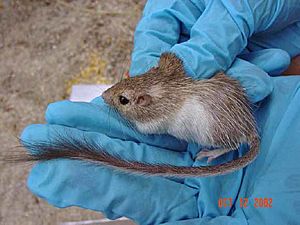Spiny pocket mouse facts for kids
Quick facts for kids Spiny pocket mouse |
|
|---|---|
 |
|
| Conservation status | |
| Scientific classification | |
| Genus: |
Chaetodipus
|
| Species: |
spinatus
|
The spiny pocket mouse (Chaetodipus spinatus) is a species of rodent in the family Heteromyidae and order Rodentia. It is found in Baja California in Mexico and in Arizona, California and Nevada in the United States.
Contents
Description
The spiny pocket mouse has long hairs. It has spines on its back that are more flexible. The existence of the spines differentiates C. spinatus from pocket mice in other genera. Their ears are small and round. They have long tails that are 126% of the length of their head and body. Their coat colors vary among islands but are generally brown on the tops of their bodies and tan on their sides. A spiny pocket mouse weighs about 13–18 g (0.46–0.63 oz). They can range in body length from 164 to 225 mm (6.5 to 8.9 in).
Range and habitat
Spiny pocket mouse are found in Southern Nevada, and in the islands of the Gulf of California at elevations up to 900 m (3,000 ft). They also range from southeast California to the south by the cape of Baja California Peninsula (Mexico) where they are native. Because of its wide range in distribution, the spiny pocket mouse population has little concern of extinction.
Diet
The spiny pocket mouse's diet is impacted by the habitat it lives in. Their diet mainly consists of seeds, desert shrubs, and grasses. At times of rainfall, they look for green vegetation. The spiny pocket mouse has to look for a water source in its food because finding a water source in their habitat is uncommon.
Behavior
The spiny pocket mouse is nocturnal. This characteristic allows the spiny pocket mouse to live in rough, rocky desert landscapes by disappearing during the hot days. The spiny pocket mouse sleeps and breeds their young in burrows.


